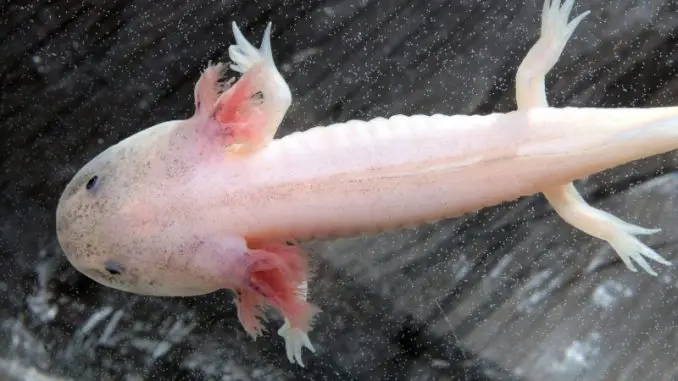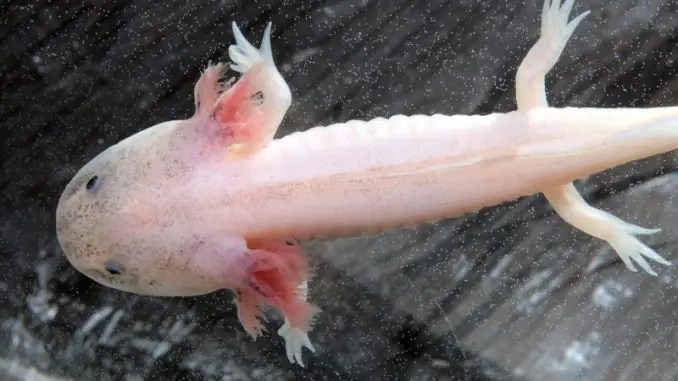
Small axolotls are a unique and attractive type of ornamental fish that will bring a lot of joy to their owners. Not only are they an interesting conversation starter, but caring for them is also surprisingly easy – as long as you understand the basics. Whether it's finding out what sets a small axolotl apart from other ornamental fish species or getting recommendations for dealing with common health problems, this blog post will walk you through everything you need to know more about find out about cute little animals. So join us on this journey as we uncover all things related to proudly owning and caring for your little axolotl.
Table of contents:
What is a small axolotl?
What is a small axolotl?
Lesser axolotls are small, aquatic salamanders native to Mexico and Central America. They have a distinctive appearance with their feathery gills, huge heads and long tails. These little creatures can make good pets for fish keepers or animal lovers who want a special feature in their aquarium.
See:
Small axolotls have a unique appearance that sets them apart from other species of salamanders. The color of their body ranges from black to brown-grey with yellow or green spots on the sides. In addition, they have feathery gills that protrude from either side of their head, giving them an almost alien appearance. The normal size of a baby axolotl when fully grown is around 10 cm.
Habitat:
In the wild, young axolotls hang out in shallow waters such as ponds, streams and canals, where they feed on worms, beetles, crustaceans and other small aquatic creatures such as tadpoles and molluscs. When it comes to aquariums, it's best to provide your pet with plenty of hiding places, such as rocks or plants, so that they feel truly safe while swimming in the aquarium. Additionally, it is important to maintain good water quality by changing at least 25% of the water every week and using dechlorinated tap water or filtered spring water when necessary.
Consumption routine:
When feeding your axolotl offspring, you should pay attention to frozen foods such as bloodworms or brine shrimp, as these are easy for them to digest and problems such as swim bladder problems will not arise later. Be sure to avoid overfeeding your pet as this can lead to weight problems, which can be very dangerous for these animals due to their delicate nature.
Small axolotls are an interesting and unique type of aquatic creature that require special care to be healthy and happy. With the right setup, water quality, temperature, and diet plan, you can provide your little axolotl with a safe home in which it is likely to thrive. Let's try recommendations for simple methods to carefully care for your pet axolotl.
The most important thing to take away: Lesser axolotls are small aquatic salamanders with distinctive feathery gills, huge heads, and elongated tails. They need to be kept in tanks with plenty of hiding places, provided with clear water and fed frozen food such as bloodworms or brine shrimp to avoid overfeeding.
Caring for a little axolotl
Caring for a little axolotl
Tank setup:
When setting up the aquarium for your little axolotl, you need to give it plenty of space. A 10-gallon tank should be sufficient and will only accommodate two or three axolotls. Make sure you provide plenty of hiding places such as rocks, driftwood and crops so that they have a place to hide when they feel pressured or scared. The substrate should also be kept shallow (1 to 2 inches) so they are unlikely to ingest anything while digging in the sand.
Water quality and temperature:
It is necessary that you keep the water clear simply by using a filter and doing frequent water changes (at least as soon as every week). The temperature should also be between 20 and 22 °C, which can only be achieved by using an aquarium heater if necessary. Additionally, make sure you use dechlorinated tap water as chlorine can cause pores and skin irritation in Axolotls.
Regular feeding of your axolotl offspring is important for their health and growth. However, overfeeding can lead to weight problems, which can put strain on the organs and lead to completely different health problems later on. Feed them every day or every other day containing a variety of foods such as worms, insects, crustaceans and other small aquatic creatures, depending on what size your pet is at the time – larger units need to be converted into smaller units mandatory.
Caring for an axolotl child requires dedication and knowledge of proper aquarium setup, water quality, temperature and feeding requirements. If these needs are met, your little axolotl may be healthy and happy. However, you need to educate yourself about common health problems that may arise to protect them from harm.
Common Factors in Small Axolotls
Small axolotls are susceptible to a number of health factors, which can be helpful to diagnose and treat. Metabolic bone disease (MBD) is probably one of the most common problems in young axolotls. MBD occurs when there is an imbalance in calcium and phosphorus levels in the body, which if left untreated can lead to weakened bones and deformities. Signs of MBD include lethargy, loss of appetite, swollen joints, a curvature of the spine or limbs, softening of the skin or skin, and skin lesions. It is important for owners to closely monitor their pet's weight loss plan, as a lack of calcium or phosphorus can lead to this example.
Skin irritation and infections are another common problem among young axolotls. Poor water quality due to high ammonia levels or improper handling can lead to skin irritation and therefore infection. Signs may include redness in the eyes or gills, white patches on the skin, lack of coloring around affected areas, increased mucus production from the gills, and decreased breathing due to inflammation from infection. To prevent these factors, it is important for owners to maintain good water quality by performing frequent water changes and avoiding excessive stress when cleaning tanks or transferring fish between containers/tanks.
If signs are apparent, it is best for owners to seek veterinary advice immediately so that an appropriate treatment plan can be quickly put in place before further problems arise.
The most important things to take away: Key takeaway: Small axolotls are susceptible to metabolic bone disease and skin irritation. To avoid these problems, owners should ensure good water quality and avoid excessive handling when cleaning tanks or moving fish. If you have any symptoms, see a veterinarian immediately.
Diploma
They're usually worth looking into, but you'll need to do your evaluation before getting one. With the right knowledge and dedication, you can provide your little axolotl with the perfect environment in which to thrive.
Are you interested in proudly owning a single pet? When it comes to young axolotls, you've come to the right place! These little amphibious creatures are a delight for any aquarium lover. Fish farming world is your source for all the information and information essential to keeping these fascinating animals happy and healthy. Find out about their diet plan, living needs and habits so that you can provide them with a very good home environment. With our help, caring for young axolotls couldn't be easier – let's get started!

